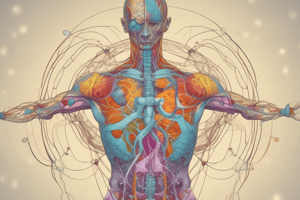Podcast
Questions and Answers
Infants have a higher amount of skeletal muscle compared to adults.
Infants have a higher amount of skeletal muscle compared to adults.
False (B)
The interstitial fluid is part of the intracellular fluid compartment.
The interstitial fluid is part of the intracellular fluid compartment.
False (B)
Healthy males have a higher percentage of body water compared to healthy females.
Healthy males have a higher percentage of body water compared to healthy females.
True (A)
The fluid portion of the blood is known as interstitial fluid.
The fluid portion of the blood is known as interstitial fluid.
Old age is associated with an increase in total body water content.
Old age is associated with an increase in total body water content.
The intracellular fluid compartment makes up about one third of the total body water.
The intracellular fluid compartment makes up about one third of the total body water.
True or false: Acidosis is characterized by high PCO2 and high bicarbonate levels.
True or false: Acidosis is characterized by high PCO2 and high bicarbonate levels.
True or false: Alkalosis is characterized by low PCO2 and high pH.
True or false: Alkalosis is characterized by low PCO2 and high pH.
True or false: The kidneys eliminate bicarbonate from the body by failing to reclaim it or by actively secreting it.
True or false: The kidneys eliminate bicarbonate from the body by failing to reclaim it or by actively secreting it.
True or false: Water content of the body is greatest at adulthood, when it is about 58%.
True or false: Water content of the body is greatest at adulthood, when it is about 58%.
True or false: Homeostatic mechanisms slow down with age, making elders more responsive to thirst clues.
True or false: Homeostatic mechanisms slow down with age, making elders more responsive to thirst clues.
True or false: Problems with fluid, electrolyte, and acid-base balance occur in the young due to a high rate of insensible water loss.
True or false: Problems with fluid, electrolyte, and acid-base balance occur in the young due to a high rate of insensible water loss.
Thirst is triggered by a decline in plasma volume or an increase in plasma osmolality
Thirst is triggered by a decline in plasma volume or an increase in plasma osmolality
Edema is an abnormal accumulation of fluid in the intracellular space
Edema is an abnormal accumulation of fluid in the intracellular space
Aldosterone regulates sodium reabsorption in the kidneys and is triggered by the renin-angiotensin mechanism
Aldosterone regulates sodium reabsorption in the kidneys and is triggered by the renin-angiotensin mechanism
Hypotonic hydration results from excessive water intake, leading to cellular overhydration
Hypotonic hydration results from excessive water intake, leading to cellular overhydration
Factors triggering ADH release include fever, sweating, vomiting, and blood loss
Factors triggering ADH release include fever, sweating, vomiting, and blood loss
Dehydration causes positive fluid balance and may lead to hypervolemic shock
Dehydration causes positive fluid balance and may lead to hypervolemic shock
Estrogens enhance NaCl reabsorption and cause water retention during menstrual cycles and edema during pregnancy
Estrogens enhance NaCl reabsorption and cause water retention during menstrual cycles and edema during pregnancy
Hydrogen ions shift in and out of cells, influencing potassium levels and interfering with excitable cells
Hydrogen ions shift in and out of cells, influencing potassium levels and interfering with excitable cells
Plasma potassium concentration influences the secretion of potassium by the collecting ducts
Plasma potassium concentration influences the secretion of potassium by the collecting ducts
Normal pH of body fluids: arterial blood is 7.4, venous blood and interstitial fluid is 7.35, intracellular fluid is 7.0
Normal pH of body fluids: arterial blood is 7.4, venous blood and interstitial fluid is 7.35, intracellular fluid is 7.0
Aldosterone stimulates potassium ion secretion by principal cells in cortical collecting ducts
Aldosterone stimulates potassium ion secretion by principal cells in cortical collecting ducts
Chloride is the major anion in the ECF, with 99% reabsorbed under normal pH conditions
Chloride is the major anion in the ECF, with 99% reabsorbed under normal pH conditions
Amphoteric molecules can function as both a weak acid and a weak base.
Amphoteric molecules can function as both a weak acid and a weak base.
The kidneys are responsible for ridding the body of metabolic acids and preventing metabolic acidosis.
The kidneys are responsible for ridding the body of metabolic acids and preventing metabolic acidosis.
Type A intercalated cells in the kidneys generate new bicarbonate ions through renal excretion of acid via hydrogen ion or ammonium ion excretion.
Type A intercalated cells in the kidneys generate new bicarbonate ions through renal excretion of acid via hydrogen ion or ammonium ion excretion.
In response to acidosis, the kidneys generate bicarbonate ions and add them to the blood, while an equal amount of hydrogen ions are added to the urine.
In response to acidosis, the kidneys generate bicarbonate ions and add them to the blood, while an equal amount of hydrogen ions are added to the urine.
Respiratory acidosis and alkalosis result from the failure of the respiratory system to balance pH, with PCO2 levels above 45 mm Hg indicating respiratory acidosis and below 35 mm Hg indicating respiratory alkalosis.
Respiratory acidosis and alkalosis result from the failure of the respiratory system to balance pH, with PCO2 levels above 45 mm Hg indicating respiratory acidosis and below 35 mm Hg indicating respiratory alkalosis.
Acid-base imbalances due to inadequacy of a physiological buffer system are compensated for by the other system, with the respiratory system attempting to correct metabolic acid-base imbalances and the kidneys working to correct imbalances caused by respiratory disease.
Acid-base imbalances due to inadequacy of a physiological buffer system are compensated for by the other system, with the respiratory system attempting to correct metabolic acid-base imbalances and the kidneys working to correct imbalances caused by respiratory disease.
Flashcards are hidden until you start studying
Study Notes
Regulation of Electrolyte and Acid-Base Balance
- Estrogens enhance NaCl reabsorption and cause water retention during menstrual cycles and edema during pregnancy
- Potassium balance affects cell membrane potential and can disrupt heart conduction
- Hydrogen ions shift in and out of cells, influencing potassium levels and interfering with excitable cells
- Cortical collecting ducts control potassium balance by changing the amount of potassium secreted into filtrate
- Plasma potassium concentration influences the secretion of potassium by the collecting ducts
- Aldosterone stimulates potassium ion secretion by principal cells in cortical collecting ducts
- Ionic calcium in ECF is crucial for blood clotting, cell membrane permeability, and secretory behavior
- PTH promotes an increase in calcium levels by targeting bones, small intestine, and kidneys
- Filtered phosphate is actively reabsorbed in the proximal tubules, regulated by its transport maximum
- Chloride is the major anion in the ECF, with 99% reabsorbed under normal pH conditions
- Normal pH of body fluids: arterial blood is 7.4, venous blood and interstitial fluid is 7.35, intracellular fluid is 7.0
- Hydrogen ions originate from cellular metabolism, anaerobic respiration, fat metabolism, and transport of carbon dioxide as bicarbonate
Renal and Respiratory Mechanisms of Acid-Base Balance
- Amphoteric molecules are protein molecules that can function as both a weak acid and a weak base
- The respiratory system regulates acid-base balance through a reversible equilibrium between dissolved carbon dioxide and water, carbonic acid, and hydrogen and bicarbonate ions
- Chemical buffers can tie up excess acids or bases, but the lungs can eliminate carbonic acid by eliminating carbon dioxide
- The kidneys are responsible for ridding the body of metabolic acids and preventing metabolic acidosis
- Renal mechanisms for regulating acid-base balance involve conserving or generating new bicarbonate ions, hydrogen ion secretion, and bicarbonate ion reabsorption
- Type A intercalated cells in the kidneys generate new bicarbonate ions through renal excretion of acid via hydrogen ion or ammonium ion excretion
- In response to acidosis, the kidneys generate bicarbonate ions and add them to the blood, while an equal amount of hydrogen ions are added to the urine
- Ammonium ion excretion involves the production of ammonium ions and bicarbonate ions from the metabolism of glutamine in proximal convoluted tubule (PCT) cells
- Type B intercalated cells exhibit bicarbonate ion secretion and reclaim hydrogen ions to acidify the blood during alkalosis
- Respiratory acidosis and alkalosis result from the failure of the respiratory system to balance pH, with PCO2 levels above 45 mm Hg indicating respiratory acidosis and below 35 mm Hg indicating respiratory alkalosis
- Metabolic acidosis, the second most common cause of acid-base imbalance, can be caused by excessive loss of bicarbonate ions, accumulation of lactic acid, shock, ketosis in diabetic crisis, starvation, and kidney failure
- Acid-base imbalances due to inadequacy of a physiological buffer system are compensated for by the other system, with the respiratory system attempting to correct metabolic acid-base imbalances and the kidneys working to correct imbalances caused by respiratory disease
Studying That Suits You
Use AI to generate personalized quizzes and flashcards to suit your learning preferences.




